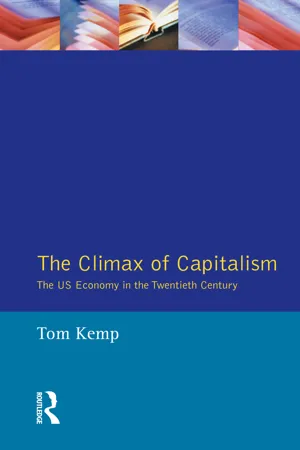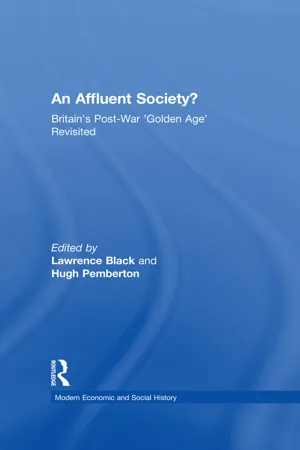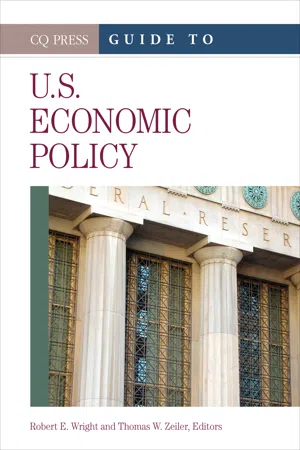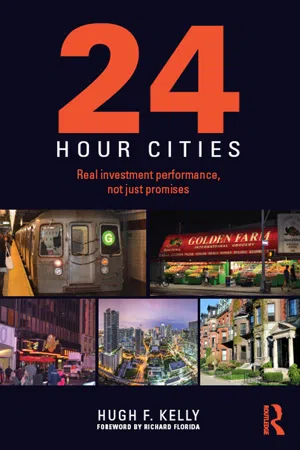History
American Economy 1950s
The American economy in the 1950s experienced a period of significant growth and prosperity, characterized by a booming manufacturing sector, increased consumer spending, and the rise of suburban living. This era saw the expansion of the middle class, the development of new technologies, and the emergence of consumer culture, all contributing to a period of economic expansion and stability.
Written by Perlego with AI-assistance
Related key terms
8 Key excerpts on "American Economy 1950s"
- eBook - ePub
The Climax of Capitalism
The U.S. Economy in the Twentieth Century
- Tom Kemp(Author)
- 2014(Publication Date)
- Routledge(Publisher)
The post-war economy: the 1950s boomThe Second World War opened a new phase in the history of American capitalism, launching it on a long-term expansion which encountered no major setback until the late 1960s. The factors which now propelled it were different from those responsible for the 1920s boom and it did not end in a crash or a slump of the 1930s type. History did not simply repeat itself, as many people at the time expected. There was no post-war slump and the feared return of the depression did not happen. On the contrary, as early as the mid-1950s, and certainly during the early 1960s, there was a confident feeling that the expansionist trend would continue indefinitely with only the mild and short-lived recessions experienced up to that time since 1945. The business cycle seemed to have been brought under control and the stagnationist hypothesis demolished. But these views were premature. American capitalism had by no means overcome its problems; but they were the problems of a new age and a different world from that of the 1920s.To understand why there was no return to depression or stagnation it is necessary to look at the changes wrought by the war, both in the domestic situation and in the relationship between the American economy and the world market. Corporate business had waxed fat on war conditions; it had built up capacity while making high profits. It was able greatly to reduce its debt burden; it was now more liquid and vastly more self-confident than it had been in the 1930s. It had the means and the technology to turn out goods on an immense scale for the civilian market as it had been doing for the war machine. Favouring the investment of liquid funds in new plant and machinery was the fact that civilian investment had been curbed by the war, following on years of low, or negative, investment during the Depression. Although clearly these factors do not account for the long-term expansion of the 1950s and 1960s they certainly inaugurated the post-war boom. - eBook - ePub
An Affluent Society?
Britain's Post-War 'Golden Age' Revisited
- Lawrence Black, Hugh Pemberton(Authors)
- 2017(Publication Date)
- Routledge(Publisher)
5Affluence and contemporary history
The emergence of the affluent society is connected with a major social transformation initiated by the industrial revolution, but only fully delivered to the majority of citizens during the 1950s and 1960s. The main features of this transformation are fairly widely known and need only be summarized briefly here. They include the completion of European industrialization, the decline of agrarian Europe and the emergence of a ‘post industrial’ society a little later. During the 1950s, economic success was based on industrial expansion and export driven growth, even for those states (such as Denmark and the Netherlands) that had previously based their prosperity on agricultural exports. Closely related to this was a general commitment to full employment, government intervention to regulate the economy and enhanced spending on welfare. A commitment to full employment and a welfare state were closely linked to industrial expansion and export growth, as it was widely recognized that only thus could the temporary instabilities caused by econofmic change be accommodated. Accompanying this was the transition to mass consumption of an ever-increasing number of products, including motor-cars, televisions and kitchen appliances. This shift is qualitative, not merely quantitative. Perhaps for the first time in history a majority of the population of most liberal democratic states actually shared in prosperity and this was maintained despite changed circumstances during the 1970s.6 Other factors which distinguish this period from previous ones include the emergence of a new wave of feminism, which created the conditions a little later for the incorporation of women more fully into society and offered for the first time a sustained challenge to patriarchy. In addition, we can also see the final secularization of public life in European political culture, a process also evident in the United States, despite its unusually high church attendance rates.7 - eBook - ePub
American Education
A History
- Wayne J. Urban, Jennings L. Wagoner, Jr., Milton Gaither(Authors)
- 2019(Publication Date)
- Routledge(Publisher)
10 Education During and After the Crucial Decade 1945–1960Overview
Most Americans greeted the end of World War II with relief as well as expectations of material improvement. Yet the period from 1945 to the mid-1950s was full of uncertainty because of crises in both domestic and foreign affairs. These crises were so monumental that historian Eric Goldman famously referred to these years as the “crucial decade.” Goldman later extended his analysis to the year 1960, believing that events from 1955 to 1960 were largely a continuation of the previous decade. Goldman’s conception of the period frames our own analysis here.1Federal Economic Activity
As World War II was drawing to a close, many Americans looked forward to a period of relative peace in foreign affairs and increasing prosperity at home. Instead, the decade following the war was characterized by substantial economic, political, and social upheaval.Domestic conflict arose over the role the federal government would play in the nation’s future. The most important single issue was the degree to which the federal government involved itself in the American economy. The Roosevelt administrations, first in response to the Great Depression and then in reaction to wartime conditions, had charted a course of substantial federal involvement in the nation’s economic affairs.This federal economic activity resulted in policies and practices that helped lower- and working-class Americans, particularly those represented by organized labor, to move into the nation’s economic mainstream. An important issue faced by the Truman administration after World War II was whether or not federal economic intervention, on behalf of both economic prosperity and the interests of organized labor and other workers, should continue.Truman’s Postwar Policies
Harry Truman, from more humble economic origins than Roosevelt, had been a small businessman prior to becoming a politician. To some, he seemed to be bent on reversing Roosevelt’s economic policies. Early in his presidency, Truman clashed openly and vigorously with labor, threatening to draft unionized railroad workers, who were on strike, into military service. Settlement of this situation prevented the nation from learning whether or not Truman would have carried out his threat. - eBook - ePub
- Robert E. Wright, Thomas W. Zeiler(Authors)
- 2014(Publication Date)
- CQ Press(Publisher)
As the United States rose in economic and political power, its leaders often found opportunities to involve themselves in foreign economic affairs in order to pursue perceived American interests. In a globalizing world economy, Americans increasingly recognized that their economic policies would affect the world, and vice versa. Americans were divided, however, over the best policies to pursue. Americans vacillated between protectionism and freer trade. Americans likewise debated the level of international commitments and use of military force that the United States should undertake to secure economic goals. Today, Americans continue to face a globalizing world and rapid economic and technological changes that powerfully impact their lives, and they continue to debate the ideal role of government policy in an industrial and highly interconnected economy.See also Chapter 1 : Early U.S. Economic Policy: Jefferson versus Hamilton (1790s–1816); Chapter 2 : The Unrestrained Business Cycle: Boom and Bust (1815–1900); Chapter 4 : The Great Depression and Its Aftermath (1929–1950s); Chapter 5 : The U.S. Economy since World War II: Unprecedented Growth, Inflation, and Stagflation (1945–2007).FURTHER READINGKeller, Morton. Regulating a New Economy: Public Policy and Economic Change in America, 1900–1933. Cambridge, MA: Harvard University Press, 1990.McGerr, Michael. A Fierce Discontent: The Rise and Fall of the Progressive Movement in America, 1870–1920. New York: Free Press, 2003.Palmer, Niall. The Twenties in America: Politics and History. Edinburgh, UK: Edinburgh University Press, 2006.Rosenberg, Emily S. Spreading the American Dream: American Economic and Cultural Expansion, 1890–1945. New York: Hill and Wang, 1982.Wiebe, Robert H. The Search for Order, 1877–1920. New York: Hill and Wang, 1967.Passage contains an image chapter 4 The Great Depression and Its Aftermath (1929–1950s)
Jason E. TaylorT HE GREAT DEPRESSION OF THE 1930S GAVE birth to modern economic policy; more specifically, it solidified the widely held notion that the federal government should attempt to steer the economy through the rough waters of the unfettered market. John Maynard Keynes’s General Theory of Employment, Interest, and Money, - eBook - ePub
A History of American Economic Thought
Mainstream and Crosscurrents
- Samuel Barbour, James Cicarelli, J. E. King(Authors)
- 2017(Publication Date)
- Routledge(Publisher)
7 Economic thought from the Great Depression through the golden age of economic growth, 1929–1973Introduction
This chapter begins in the year of the Wall Street crash and ends in the year in which the Bretton Woods system broke down. In between there was a decade of deep depression and faltering recovery (1929–1941), four years of world war (1941–1945) and almost three decades of sustained prosperity, the so-called ‘golden age’ of post-war American – and indeed global – capitalism (1945–1973). There were equally dramatic changes in the nature of American economics, which was completely transformed. By 1973 formal modeling and rigorous econometric techniques were the norm, rather than the preserve of a small minority as had been the case in 1929. The earlier pluralism of ideas and methods had given way to an increasingly monolithic neoclassical mainstream, which was exerting great influence over the ways in which economics was taught and practised all over the world. This is covered below. For most of the period the ‘Other Voices’ and ‘Crosscurrents’ were operating in an increasingly difficult intellectual and institutional environment. At the very end of the period, however, there were some indications that dissident ideas were beginning to revive.Economic, social, political conditions
In 1930 the population of the United States was 122.8 million, 11.6 percent of whom had been born overseas. By 1970 total US population had risen to 203.3 million, but the virtual cessation of mass immigration for two decades after 1929 meant that only 4.8 percent were now foreign-born, the lowest proportion ever recorded (Hughes and Cain 2011, 558). It was an increasingly urbanized population, with the proportion employed in primary production (agriculture, forestry, and fishing) falling from 17.4 percent in 1940 to a mere 3.1 percent in 1970. Those working in the secondary sector (manufacturing, construction, and transport) rose from 39.0 percent in 1940 to an all-time high of 41.0 percent in 1950, before beginning a slow but steady and continuing relative decline to 35.8 percent in 1970. Employment in the tertiary sector rose steadily, from 43.5 percent of total employment in 1940 to 61.1 percent in 1970, by which time the United States was well on the way to becoming a service economy (Hughes and Cain 2011, 567). - eBook - ePub
- John Rees(Author)
- 2006(Publication Date)
- Routledge(Publisher)
2 US economic power in the age of globalisation
The world economy is made up of the totality of economic activity by competing states and corporations. This totality of economic activity has its own patterns of development that are characterised by certain general trends. The period from the Second World War to the 1970s was, for example, a period of high growth and limited recessions. The period since the 1970s has seen growth rates halve and the return of the boom–bust cycle. Again, the middle decades of the 20th century were dominated by certain state-led forms of development not just in the Eastern bloc but also in the welfare-state/ nationalisation economies of the West and in the developmental models of the Third World. In the period since the 1970s, the neoliberal era, the role of the state has not been reduced but it has been altered so that it is now much more the facilitator of global corporations. These kind of general characteristics of the world economy as a whole will be examined in chapter four .This chapter is concerned with the relationships between the competing parts of the economy, predominantly with the economic strengths and weaknesses of the different states that compose the system. This competition is the origin of the general patterns in the world economy, patterns produced by blind interaction rather than conscious intention. But the weight and position of the competing states within this wider pattern is often the element that drives the system beyond economic competition towards military conflict.The scene at the end of the Second World War
When the victors of the Second World War–Britain, Russia and America–met at the Yalta and Potsdam conferences in 1945 they set about constructing a new world order. Churchill had set the tone on an earlier visit to Moscow. He wrote down how he saw the post-war world on a sheet of paper. Russia would have 90 percent of the say in Romania, Britain 90 percent of the say in Greece and they would share Hungary and Yugoslavia. Churchill records, ‘I pushed this across to Stalin. Then he took his blue pencil and made a large tick upon it, and passed it back to us. It was all settled in no more time than it takes to set down.’ - eBook - ePub
- Carlos Sabillon(Author)
- 2019(Publication Date)
- Routledge(Publisher)
Investments in space goods were seen in the same way as those spent on armaments. The efforts to produce these goods were seen as wasteful, as subtractions of wealth, and as obstacles to progress. In the vision of most intellectuals and politicians, the only way in which investment in these two types of goods could be justified was national security or national pride. However, notwithstanding the apparently large-scale waste of resources in weapons and space goods, the economy performed very well; and despite the increase in the share of “wasted” resources from GDP, economic growth even accelerated its pace. After having grown by about 3.8 percent in the 1950s, GDP expanded by about 4.2 percent annually during the 1960s.The empirical evidence clearly demonstrates that there was something intrinsically wrong with the vision of the world of most intellectuals and policy makers of the time. If their premise was right, the economy should have performed poorly and below the rate of the 1950s, and the 1950s and the 1940s should have been characterized by stagnation or worse. Only by conceding that manufacturing is the principal agent that makes growth possible do the events of these decades become rationally explainable. Factory output corresponded very closely as it expanded by about 5.3 percent annually during the 1960s.12For such a premise to be logically consistent, the historical evidence would have to demonstrate some form of strong causal linkage between this sector and technology. The empirical data would have to indicate that manufacturing is fundamentally responsible for the creation and diffusion of technology. Since technology is the prime generator of wealth, if such a historical correlation existed it would be understandable why, while large amounts of goods with no private sector demand were being produced, the wealth of the nation was rapidly increasing. The historical evidence reveals such a correlation.The rate by which technology expanded was much faster during the 1960s, 1950s, and 1940s than during the 1930s, when practically no resources were being wasted in weapons or grandiose space projects. Also worth noting is that most of the patents during these decades were directly attached to manufactored goods such as aircraft, missiles, electric instruments, electronic machinery, communication equipment, satellites, tanks, chemicals, motor vehicles, and machine tools.The technology that was created as weapons and space goods were produced soon found a civilian application, which is how society profited considerably from those investments. Satellites, for example, originated by largely enhancing knowledge about the enemy’s forces and therefore improving the defense capabilities of the nation. Soon, however, they started transmitting a huge amount of information about the weather and climate, about geography and topography, and geology and cartography, and were used for radio broadcasts, television signals, electronic paging requests, newspaper layouts, and even credit card transactions.13 - eBook - ePub
24-Hour Cities
Real Investment Performance, Not Just Promises
- Hugh F. Kelly(Author)
- 2016(Publication Date)
- Routledge(Publisher)
2 The 1950s A revolutionary decade?Often viewed as the calm before the storm, the 1950s set in motion trends as revolutionary for cities as any decade before or since. Physically, mentally, culturally, aspirationally, competitively, American urban life in 1960 was vastly different from what it was in 1950. Although the gradual pace of change masked its profound implications, and although each individual component could be viewed as benign, the sum of the differences set the stage for a redefining of cities that would last until nearly the end of the 20th century.The 1950s were the heart of the Baby Boom years, by many accounts the most significant demographic event in American history. During the decade, US births averaged 4 million per year, an unprecedented population increase. Total population grew 18.7 percent between 1950 and 1960, from 151 million to 180 million. The share of US population living in central cities edged downward, from 32.8 percent to 32.3 percent, and the share for the suburbs grew from 23.3 percent to 30.9 percent. With the large overall population gain, of course, the absolute population of central cities was up by 8.6 million residents, and few saw any cause for alarm in what seemed to be a “win–win” proposition. Such complacency would soon be confounded.1Between 1900 and 1940, the home ownership rate for the United States fluctuated narrowly between 43.6 percent and 47.8 percent. Largely owing to the 1944 GI Bill’s support for veterans’ mortgages, home ownership became the majority form of housing tenure by 1950, at 55.0 percent of US households. (The Veterans Administration had backed 2.4 million home loans by 1952.) US home ownership surged to 61.9 percent by 1960 and has remained between 60 percent and 70 percent ever since.The GI Bill also provided education benefits for servicemen returning from World War II. In 1947, 5.6 percent of Americans aged 25 or older had 4-year college degrees. But, with the new government support, veterans accounted for 49 percent of all college admissions, and, by 1950, 7.7 percent of the 25-and-over population held bachelor’s degrees or higher. By 1959, that figure was 11.1 percent, roughly double the 1947 ratio. As the Boomers hit college age themselves, the ratio would redouble again, hitting 24.0 percent by 1977.2
Learn about this page
Index pages curate the most relevant extracts from our library of academic textbooks. They’ve been created using an in-house natural language model (NLM), each adding context and meaning to key research topics.







